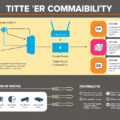In our increasingly digitized world, the transfer of information occurs at lightning speed between computers and devices. Central to this seamless communication are data packets—structured units of information that facilitate the high-speed transfer of data over networks. This article explores the definition, structure, and significance of data packets, and examines their role in network communication.
What are Data Packets?
A data packet is a formatted unit of data carried by a packet-switched network. This can be likened to postal mail: just as a letter is sent in an envelope (the packet header contains the address), data packets compartmentalize larger messages into smaller, manageable parts for efficient transmission across the internet.
When users send various forms of digital data—whether text, images, or videos—the information is broken down into individual data packets. These packets travel through the network, often taking different routes to reach the same destination, where they are reassembled into the original format. This method enhances both speed and efficiency in digital communication.
Structure of a Data Packet

Understanding the structure of a data packet is essential for grasping how data is transmitted over networks. A typical data packet consists of three main components:
-
Header:
- The header contains vital information including the sender’s and receiver’s IP addresses, the packet size, and the type of protocol being used (like TCP or IP). It may also include a sequence number to help reconstruct the original message order and a checksum to verify data integrity.
-
Payload:
- This is the core data being transmitted, such as a portion of a file or a multimedia element. The payload makes up the bulk of the packet, carrying the actual content meant for the recipient.
-
Trailer:
- While optional and not always included, a trailer typically marks the end of the packet. It may contain additional error-checking codes like a Cyclic Redundancy Check (CRC) to further ensure the data’s integrity upon arrival.
This structured approach allows error detection, data integrity checks, and efficient routing, enabling reliable communication over increasingly complex networks.
The Role of Data Packets in Network Communication
1. Efficiency of Transmission
The use of data packets significantly enhances network performance. Breaking down large data into smaller packets allows multiple packets from different sources to travel through shared bandwidth simultaneously, maximizing the use of available line capacity. Packet switching, as opposed to the older circuit switching method, enables this concurrent data flow.
2. Flexible Routing
One of the significant advantages of packets is their ability to take multiple routes to reach their destination. If one route encounters congestion or failure, packets can be rerouted, ensuring that data arrives efficiently and without needing to wait for a single continuous connection.
3. Error Handling and Recovery
Packets come equipped with error detection and correction capabilities. If a packet is lost or corrupted in transit, protocols can trigger a retransmission, maintaining the integrity of the overall data stream. This aspect is crucial for applications requiring reliable communication, such as video conferencing or online gaming, where any data loss can disrupt the user experience.
Conclusion
Data packets are foundational to the modern internet—a fact that highlights their importance in the world of networking and communication. Understanding how they function provides insights into not only how data is communicated but also how networks achieve high efficiency and reliability. As technology continues to evolve, the principles and practices surrounding data packets will remain central to ensuring efficient digital communication in our interconnected world.
By appreciating the role of data packets, professionals and novices alike can navigate the complexities of computer networking and contribute to an ever-increasing digital landscape.



